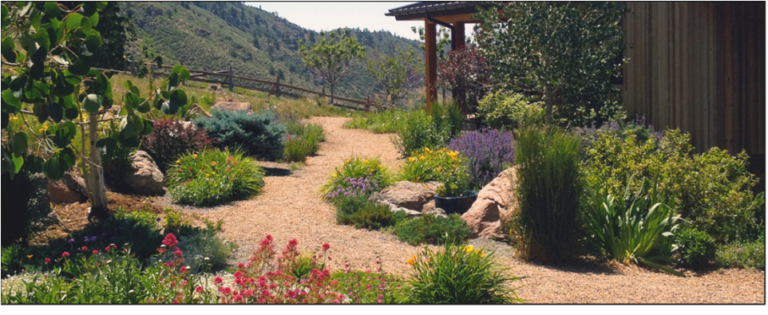Sustainable water management techniques are more crucial than ever as worries about water scarcity and climate change grow. Xeriscaping, a landscaping method created especially for areas prone to drought, is one of the most efficient ways to conserve water in landscaping. In addition to conserving water, xeriscaping produces attractive, low-maintenance landscapes that may survive in arid environments. The ideas, advantages, and key components of xeriscaping will be covered in detail in this article, along with useful advice for putting this water-saving landscaping technique into practice.
Understanding Xeriscaping
Water conservation is of utmost importance in the dry parts of the western United States, where xeriscaping is a landscaping philosophy that was developed. Moreover, the word “xeriscape” is a combination of the Greek terms “xeros,” which means dry, and “scape,” which means scene or view. Therefore, the art of creating and managing landscapes in a way that minimizes the demand for irrigation and maximizes water efficiency is known as xeriscaping.
Core Principles:
- Water Conservation: Xeriscaping aims to reduce water consumption significantly, making it a sustainable choice in regions with limited water resources. This is achieved by using drought-tolerant plants and minimizing the use of traditional lawns and thirsty plant species.
- Appropriate Plant Selection: Selecting plants that are well-suited to the local climate is crucial in xeriscaping. Drought-resistant and native plants are often preferred for their ability to thrive with minimal water.
- Efficient Irrigation: When irrigation is necessary, xeriscapers use efficient watering techniques such as drip irrigation or soaker hoses. These methods deliver water directly to the roots, minimizing wastage through evaporation and runoff.
- Mulching: Mulch is a key component of xeriscaping as it helps retain soil moisture, regulate soil temperature, and reduce weed growth. Organic mulches, such as wood chips or compost, are commonly used.
- Soil Improvement: Healthy soil is essential for water retention and plant health. Xeriscapers focus on improving soil quality through techniques like amending with organic matter and proper soil preparation.
- Practical Turf Areas: Traditional lawns are water-intensive and often unsuitable for xeriscaping. Xeriscapers reduce turf areas or replace them with drought-resistant grasses.
- Practical Design: Xeriscaping embraces practical design principles, such as grouping plants with similar water needs together and creating functional outdoor spaces.
Benefits of Xeriscaping
Xeriscaping offers a wide range of benefits beyond water conservation:
- Water Savings: The most evident advantage is significant water savings. By reducing the need for frequent watering, xeriscaping can help homeowners and communities conserve valuable water resources.
- Cost Savings: Lower water bills are a direct result of xeriscaping. With less need for irrigation, homeowners can save money on their monthly utility bills.
- Reduced Maintenance: Xeriscapes are typically low-maintenance landscapes. Once established, they require less time, effort, and resources for upkeep compared to traditional lawns and gardens.
- Increased Property Value: Well-designed xeriscapes can enhance the curb appeal and property value of homes. They are visually striking and can attract potential buyers looking for sustainable and aesthetically pleasing landscaping.
- Biodiversity: Native and drought-resistant plants used in xeriscaping can support local wildlife and promote biodiversity. They provide habitats for pollinators like bees and butterflies.
- Resilience: Xeriscapes are better equipped to withstand droughts, heatwaves, and other extreme weather conditions, making them more resilient landscapes.
- Environmental Benefits: By reducing water consumption and the use of synthetic fertilizers and pesticides, xeriscape contributes to a healthier environment with less pollution.
Essential Elements
To successfully implement xeriscaping, it’s essential to understand the core elements that make up this landscaping approach:
- Plant Selection: Choose drought-tolerant and native plants that thrive in your region. Consult with local nurseries or gardening experts to identify the best choices for your specific climate.
- Efficient Irrigation: If irrigation is necessary, opt for efficient systems like drip irrigation or soaker hoses. Proper watering schedules and techniques are crucial to ensure plants receive just the right amount of moisture.
- Mulching: Apply mulch to conserve soil moisture, suppress weeds, and maintain soil temperature. Mulch also enhances the aesthetic appeal of the landscape.
- Soil Improvement: Invest time in improving your soil quality. Amending with compost or organic matter can enhance water retention and nutrient availability for your plants.
- Practical Turf Areas: If you desire a lawn in your xeriscape, consider replacing traditional grass with drought-resistant varieties like buffalo grass or blue grama grass. Minimize the turf area to reduce water consumption.
- Functional Design: Design your xeriscape with practicality in mind. Create outdoor living spaces, walking paths, and zones with similar water requirements to make maintenance easier.
- Maintenance: Regular maintenance is still necessary for xeriscapes, but it’s typically less intensive than traditional landscapes. Pruning, weeding, and occasional irrigation adjustments are part of the upkeep.
Practical Tips
Moreover, here are some practical tips for those interested in xeriscaping their own outdoor spaces:
- Plan Thoroughly: Start with a well-thought-out plan that considers your local climate, soil type, and specific site conditions. Furthermore, this planning phase is crucial for the success of your xeriscape.
- Choose Wisely: Select plants based on their water needs and compatibility with your region. Native plants are often the best choice as they have adapted to local conditions.
- Group Plants by Water Needs: Grouping plants with similar water requirements together simplifies irrigation and ensures efficient water usage.
- Install Drip Irrigation: Drip irrigation systems deliver water directly to plant roots, minimizing wastage. Consider installing a timer to automate watering schedules.
- Use Organic Mulch: Apply a 2-4 inch layer of organic mulch around plants to retain moisture, regulate soil temperature, and reduce weed growth.
- Consider Hardscaping: Incorporate hardscape elements like gravel, stones, or pavers to reduce the overall landscaped area, which in turn reduces water demand.
- Prune Regularly: Pruning helps maintain the health and shape of your plants while reducing water requirements.
- Monitor Soil Moisture: Invest in a soil moisture meter to keep track of soil moisture levels. Hence, it can help prevent overwatering.
- Collect Rainwater: Install rain barrels or other rainwater harvesting systems to capture and store rainwater for irrigation.
- Educate Yourself: Continue to educate yourself about xeriscaping and its maintenance practices. Attend workshops or consult with local experts for guidance.
Xeriscape in a nutshell
In a time when protecting our planet’s limited resources is of utmost importance, xeriscaping appears as a ray of hope and ingenuity. The adoption of sustainable practices in landscaping becomes more than simply a choice as we deal with the increasing problems of water shortages and climate change. Furthermore, With its foundation in water conservation, wise plant selection, and deliberate design, xeriscaping offers a solution that goes beyond the boundaries of arid places and challenges us all to reconsider how we use our outdoor spaces.
Moreover, by embracing xeriscaping, we protect our water supply and gain access to its many advantages, like cheaper water bills, less upkeep, higher property value, and peaceful coexistence with the environment. Let this investigation of xeriscaping serve as a call to action to set out on a path towards resilient, drought-resistant landscapes that not only meet today’s difficulties but also honor the beauty and resiliency of nature in its most resourceful manifestation.







